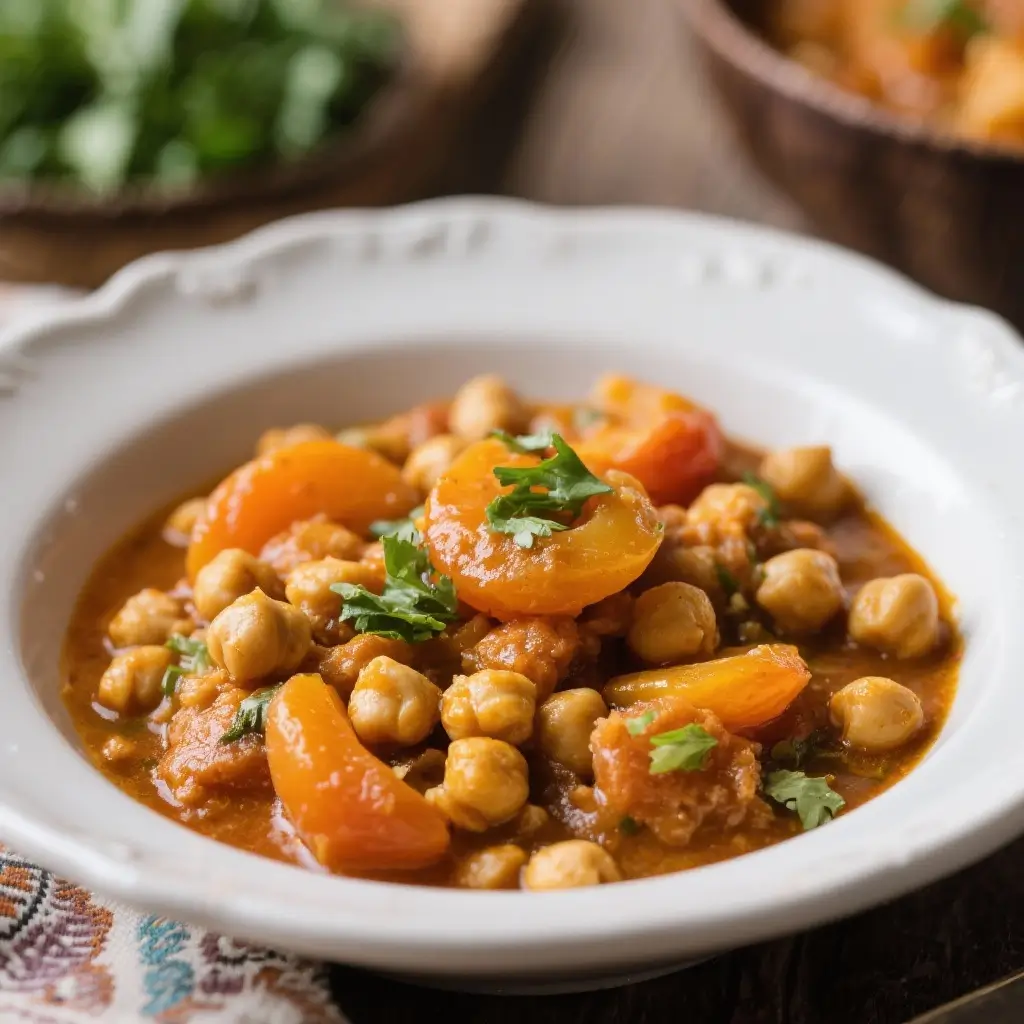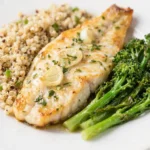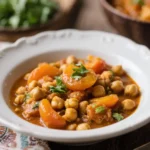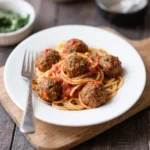Vegan Moroccan Chickpea & Apricot Stew
Warm, aromatic, and rich in complex flavors, this Vegan Moroccan Chickpea & Apricot Stew is a celebration of North African cuisine reimagined through a plant-based lens. This hearty stew brings together the earthy depth of chickpeas, the sweet-tart pop of dried apricots, and a symphony of warming spices to create a dish that’s both nourishing and soul-satisfying. Whether you’re an experienced vegan cook or just exploring meatless meals, this stew promises comfort in every spoonful.
The History
Moroccan cuisine has long been celebrated for its intricate spice blends, slow-cooked stews, and vibrant use of fruits and legumes. Rooted in Berber, Arab, Andalusian, and Mediterranean culinary traditions, Moroccan food emphasizes balance—between sweet and savory, texture and temperature, simplicity and complexity. One of its most iconic dishes, Tagine, named after the conical clay pot it’s traditionally cooked in, often features slow-simmered meats with dried fruits like apricots, prunes, or raisins, and nuts such as almonds or cashews.
This Vegan Moroccan Chickpea & Apricot Stew draws direct inspiration from classic tagine recipes but adapts them for modern, plant-based palates. By replacing animal protein with protein-rich chickpeas and using vegetable broth instead of meat stock, we preserve the essence of the original while making it accessible to vegans and vegetarians alike. The use of apricots—a staple in Moroccan cooking—not only adds natural sweetness but also connects this dish to centuries-old trade routes where dried fruits were prized commodities along caravan trails across the Sahara.
In homes throughout Morocco, especially during Ramadan or family gatherings, such stews are served communally, often scooped up with crusty bread or fluffy couscous. Our version honors these traditions while embracing sustainability, health-conscious choices, and global accessibility, proving that traditional flavors can thrive without animal products.
Ingredients Breakdown
The magic of this stew lies in the harmony between its ingredients—each one playing a crucial role in building layers of flavor, texture, and nutrition. Let’s explore them in detail:
- Chickpeas: The star protein source, chickpeas (also known as garbanzo beans) offer a creamy texture and nutty flavor. Rich in fiber, plant-based protein, iron, and folate, they make this stew filling and nutritious. Canned chickpeas are convenient, but soaked and cooked dried chickpeas yield superior texture and depth.
- Dried Apricots: These provide a burst of natural sweetness balanced by a subtle tang. They soften during cooking, blending into the sauce and releasing fruity notes that contrast beautifully with warm spices. Choose unsulfured apricots when possible for a cleaner taste and deeper color.
- Onions and Garlic: The aromatic foundation. Slowly caramelized onions add sweetness and body, while garlic contributes pungency and depth. Together, they form the flavor base upon which the entire stew is built.
- Fresh Ginger and Turmeric: Fresh ginger adds zing and warmth, enhancing digestion and bringing brightness. Turmeric not only imparts a golden hue but also contributes earthiness and potent anti-inflammatory properties.
- Tomatoes: Whether in canned crushed form or fresh purée, tomatoes lend acidity and moisture, helping balance the richness of the other ingredients while contributing lycopene and vitamin C.
- Olive Oil: Used for sautéing, extra virgin olive oil adds fruitiness and helps unlock fat-soluble vitamins in spices like turmeric. It also enriches the mouthfeel of the final dish.
- Spices: A blend of ground cumin, coriander, cinnamon, smoked paprika, and a pinch of cayenne creates the signature Moroccan profile. Cumin offers earthiness, coriander brings citrusy notes, cinnamon adds sweetness, smoked paprika gives depth and smokiness, and cayenne introduces gentle heat.
- Vegetable Broth: The liquid medium that carries all flavors. Use low-sodium organic broth to control salt levels and enhance clarity of taste. Homemade vegetable stock elevates the dish even further.
- Lemon Juice: Added at the end, lemon juice brightens the stew, cutting through the richness and lifting the overall flavor profile.
- Fresh Herbs (Cilantro and Parsley): Chopped cilantro adds a fresh, citrusy finish, while parsley lends color and mild bitterness. Both are added just before serving to preserve their vibrancy.
- Optional Add-ins: Almonds (toasted or slivered), preserved lemons, or a swirl of coconut milk can be incorporated for extra richness, crunch, or tang.
Step-by-Step Recipe
- Prep Ingredients: Drain and rinse the chickpeas. Chop the onion finely, mince the garlic, grate the fresh ginger and turmeric (if using fresh), slice the dried apricots into halves or thirds, and measure out all spices.
- Sauté Aromatics: In a large, heavy-bottomed pot or Dutch oven, heat 3 tablespoons of olive oil over medium heat. Add the chopped onions and a pinch of salt. Cook slowly for 8–10 minutes, stirring occasionally, until the onions are soft and lightly golden. Avoid browning too quickly; slow cooking builds sweetness.
- Add Garlic and Spices: Stir in the minced garlic, grated ginger, and turmeric. Cook for 1 minute until fragrant. Then, add the ground cumin, coriander, cinnamon, smoked paprika, and cayenne. Stir constantly for 30 seconds to toast the spices—this step unlocks their essential oils and intensifies flavor.
- Incorporate Tomatoes: Pour in the crushed tomatoes (with juices). Stir well and simmer for 5 minutes, allowing the mixture to thicken slightly and develop a rich base.
- Add Chickpeas and Liquid: Stir in the drained chickpeas and sliced apricots. Pour in 3 cups of vegetable broth. Bring the mixture to a gentle boil, then reduce the heat to low.
- Simmer Gently: Cover the pot partially and let the stew simmer for 35–45 minutes, stirring occasionally. The longer it simmers, the more the flavors meld. If the stew becomes too thick, add more broth or water, ¼ cup at a time.
- Season and Finish: Taste and adjust seasoning—add salt and black pepper as needed. Stir in 1–2 tablespoons of fresh lemon juice. Remove from heat.
- Garnish and Serve: Sprinkle generously with chopped fresh cilantro and parsley. For added texture, top with toasted sliced almonds or a drizzle of olive oil. Serve hot.
Tips
- Toasting Spices is Key: Never skip toasting your spices with the aromatics. It transforms raw, dusty powders into vibrant, aromatic compounds that define the dish.
- Low and Slow Cooking: Simmering gently allows the apricots to plump up and infuse their sweetness into the broth while preventing the chickpeas from breaking apart.
- Balancing Sweet and Savory: If the stew tastes too sweet from the apricots, add a splash more lemon juice or a pinch of salt. If it’s too tart, stir in half a teaspoon of maple syrup or agave nectar.
- Texture Control: For a creamier stew, mash a small portion of the chickpeas against the side of the pot with a wooden spoon before serving. This thickens the broth naturally.
- Make Ahead Magic: This stew tastes even better the next day. Cool completely and store in the refrigerator for up to 4 days. Reheat gently on the stove with a splash of broth.
- Cooking Dried Chickpeas? Soak 1 cup of dried chickpeas overnight, then boil in fresh water for 60–90 minutes until tender. Use 2½ cups cooked chickpeas in place of canned.
- Use Quality Olive Oil: Since it’s used early in cooking and impacts flavor, opt for a good-quality extra virgin olive oil with fruity notes.
Variations and Customizations
This recipe is wonderfully adaptable to different tastes, dietary needs, and seasonal ingredients:
- Fruit Swaps: Replace apricots with pitted prunes, raisins, dates, or dried cranberries. Each brings a unique sweetness and texture—prunes add deep molasses-like tones, while dates contribute caramel richness.
- Protein Boost: Add cubed tofu, tempeh, or cooked lentils for additional plant-based protein. Marinate tofu in lemon juice and spices before pan-frying for extra flavor.
- Vegetable Additions: Include diced carrots, sweet potatoes, zucchini, or bell peppers during the simmering stage. Root vegetables should be added earlier (with the broth); softer veggies go in the last 15 minutes.
- Coconut Cream Version: For a richer, creamier texture, replace 1 cup of vegetable broth with full-fat coconut milk. This adds a luxurious mouthfeel and pairs beautifully with the apricots and spices.
- Nut Variations: Toasted slivered almonds are classic, but try pine nuts, chopped walnuts, or pistachios for different crunch and flavor profiles.
- Smoky Twist: Add a tiny drop of liquid smoke or increase smoked paprika for a deeper, campfire-like note—ideal for mimicking traditional clay-pot cooking.
- Gluten-Free Friendly: Naturally gluten-free, this stew is perfect for those avoiding gluten. Just ensure your vegetable broth is certified GF if needed.
- Spice Level Adjustment: Omit cayenne for mildness, or add harissa paste (½–1 tsp) for North African heat. Fresh chili slices work too.
Health Considerations and Nutritional Value
This Vegan Moroccan Chickpea & Apricot Stew isn’t just delicious—it’s a powerhouse of nutrition:
- High in Fiber: Chickpeas and apricots are excellent sources of dietary fiber, promoting digestive health, regulating blood sugar, and supporting gut microbiota.
- Plant-Based Protein: With about 10–12 grams of protein per serving (depending on portion size), this stew supports muscle maintenance and satiety without relying on animal products.
- Rich in Micronutrients: Chickpeas provide iron, magnesium, phosphorus, and B-vitamins (especially folate). Apricots contribute vitamin A (from beta-carotene), potassium, and antioxidants like lutein and zeaxanthin, beneficial for eye health.
- Anti-Inflammatory Benefits: Turmeric contains curcumin, a compound with strong anti-inflammatory and antioxidant effects. Pairing it with black pepper (optional addition) and healthy fats (olive oil) enhances absorption.
- Heart-Healthy Fats: Olive oil provides monounsaturated fats, linked to reduced risk of cardiovascular disease and improved cholesterol levels.
- Natural Sweetness Without Refined Sugar: The apricots eliminate the need for added sugars, offering sweetness along with nutrients and fiber.
- Low Glycemic Impact: Thanks to fiber and protein content, this stew has a moderate glycemic response, making it suitable for diabetics when consumed in balanced portions.
- Supports Weight Management: High volume, nutrient density, and satiating qualities help prevent overeating and support long-term weight goals.
Nutrition Estimate (per serving, serves 6):
Calories: ~280 | Protein: 11g | Fat: 9g (mostly unsaturated) | Carbohydrates: 42g | Fiber: 10g | Sugar: 14g (natural) | Sodium: ~400mg (adjustable) | Iron: 25% DV | Vitamin A: 30% DV
Ingredients
- 2 tablespoons olive oil (plus more for serving)
- 1 large yellow onion, finely chopped
- 4 cloves garlic, minced
- 1 tablespoon fresh ginger, grated
- 1 teaspoon fresh turmeric, grated (or ½ tsp ground)
- 1 (14.5 oz) can diced tomatoes or 1.5 cups crushed tomatoes
- 2 (15 oz) cans chickpeas, drained and rinsed (or 3 cups cooked)
- 1 cup dried apricots, roughly chopped
- 3 cups low-sodium vegetable broth
- 1 teaspoon ground cumin
- 1 teaspoon ground coriander
- 1 teaspoon ground cinnamon
- ½ teaspoon smoked paprika
- ¼ teaspoon cayenne pepper (optional)
- Salt and black pepper to taste
- 2 tablespoons fresh lemon juice (about 1 lemon)
- ½ cup fresh cilantro, chopped
- ¼ cup fresh parsley, chopped
- ¼ cup sliced almonds, toasted (optional garnish)
Directions
- Heat olive oil in a large pot over medium heat. Add onions and a pinch of salt. Sauté for 8–10 minutes until soft and golden.
- Add garlic, ginger, and turmeric. Stir for 1 minute until fragrant.
- Stir in cumin, coriander, cinnamon, smoked paprika, and cayenne. Toast spices for 30 seconds.
- Pour in crushed tomatoes and simmer for 5 minutes, stirring occasionally.
- Add chickpeas, apricots, and vegetable broth. Stir well and bring to a gentle boil.
- Reduce heat to low, cover partially, and simmer for 35–45 minutes, stirring occasionally.
- Season with salt, pepper, and lemon juice. Adjust spices to taste.
- Remove from heat. Stir in fresh herbs. Garnish with toasted almonds if desired.
- Serve hot with couscous, quinoa, crusty bread, or over brown rice.
FAQ
Can I freeze this stew?
Yes! This stew freezes exceptionally well. Cool completely, then transfer to airtight containers or freezer-safe bags. Freeze for up to 3 months. Thaw overnight in the fridge and reheat on the stove with a splash of broth.
Is this stew spicy?
Not inherently. The cayenne adds mild warmth, but you can omit it entirely. For more heat, add harissa, red pepper flakes, or fresh chili.
Can I make it in a slow cooker?
Absolutely. Sauté onions, garlic, and spices first, then transfer to a slow cooker. Add remaining ingredients (except lemon juice and herbs). Cook on Low for 6–7 hours or High for 3–4 hours. Stir in lemon juice and herbs before serving.
What can I serve with this stew?
Traditional pairings include fluffy couscous, quinoa, or millet. It also goes well with flatbreads like pita or naan. A simple green salad with lemon vinaigrette complements the richness perfectly.
Are there any allergens?
This recipe is naturally free of dairy, eggs, soy (check broth labels), and gluten (verify broth). Almonds are optional, so omit for nut-free diets.
Why are my apricots too chewy?
If using very dry or thick apricots, soak them in warm water or broth for 10–15 minutes before adding to the stew. This softens them and speeds up integration.
Can I use fresh apricots?
In season, yes! Substitute 1.5 cups diced fresh apricots. Add them in the last 15 minutes of cooking to prevent over-softening.
Summary
This Vegan Moroccan Chickpea & Apricot Stew marries ancient North African flavors with modern plant-based nutrition, delivering a fragrant, satisfying meal bursting with sweet, savory, and spicy notes. Hearty, healthy, and endlessly customizable, it’s a bowl of warmth that nourishes both body and spirit.










